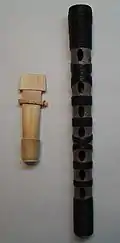篳篥
Chinese
| phonetic | |||
|---|---|---|---|
| trad. (篳篥) | 篳 | 篥 | |
| simp. (筚篥) | 筚 | 篥 | |
| alternative forms | |||
Etymology
Borrowed from a language in the Western Regions. Compare Khotanese *pīlī (“pipe?”) (as in pīlīrūvī (“clyster-pipe”)).
Pronunciation
Noun
篳篥
Descendants
- → Korean: 피리 (piri, “reed wind instrument”)
Japanese
| Kanji in this term | |
|---|---|
| 篳 | 篥 |
| ひち Hyōgaiji |
りき Hyōgaiji |
| on’yomi | |

篳篥 (hichiriki)
Pronunciation
References
- Matsumura, Akira, editor (2006), 大辞林 [Daijirin] (in Japanese), Third edition, Tōkyō: Sanseidō, →ISBN
This article is issued from Wiktionary. The text is licensed under Creative Commons - Attribution - Sharealike. Additional terms may apply for the media files.